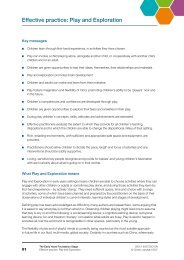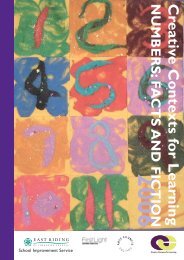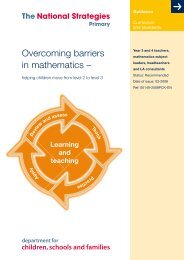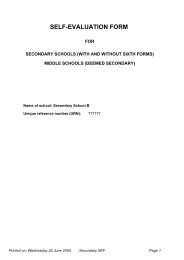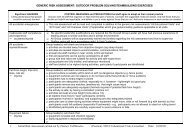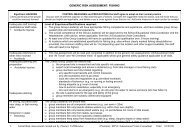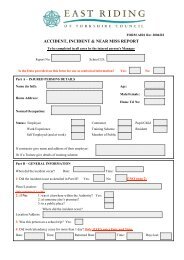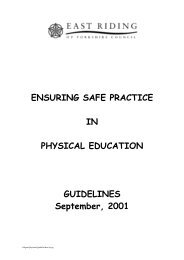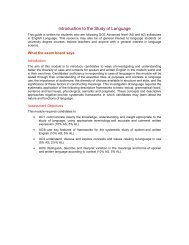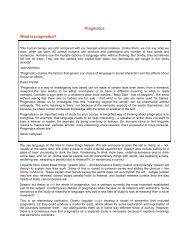Artificial Ski Slope Skiing - eRiding
Artificial Ski Slope Skiing - eRiding
Artificial Ski Slope Skiing - eRiding
Create successful ePaper yourself
Turn your PDF publications into a flip-book with our unique Google optimized e-Paper software.
GENERIC RISK ASSESSMENT: ARTIFICIAL SLOPE SKIING/SNOWBOARDING<br />
Significant HAZARDS<br />
Likely places/ways that people<br />
could be seriously harmed<br />
CONTROL MEASURES and PRECAUTIONS that staff agree to adopt as their normal practice<br />
Discuss with all staff that organise or help lead this type of visit. Consider the suggested measures below, and tick those that you<br />
decide are helpful and applicable, and delete or put a cross against those that are not. Add extra measures in each section as needed.<br />
All accidents/ emergencies This risk assessment will be read and completed in addition to the generic risk assessments “All Educational Visits”<br />
and “All Travel” and “All Overseas Visits” (if applicable) which give general safety guidance applicable to all visits.<br />
Staff will fully understand and be prepared to fulfil their supervision responsibilities e.g. accompanying sick or injured<br />
group members to/in hospital<br />
Group leaders will continue to supervise and maintain responsibility for the young people during activities<br />
Group members will know where and how to contact a staff member in an emergency<br />
Meeting points will be agreed for the start and end of ski sessions<br />
Staff will discuss and establish an emergency procedure in the event of a group member being injured and needing<br />
hospitalisation<br />
Visits inadequately<br />
planned/organised<br />
Accidents<br />
Inadequate safety standards<br />
of instructors/ leaders<br />
Accidents<br />
Inadequate equipment<br />
Injuries<br />
Slips/falls/collisions<br />
Injuries<br />
<br />
<br />
<br />
<br />
<br />
<br />
The Overall Group Leader will be a competent leader, with adequate experience of leading (or assisting leading)<br />
similar visits<br />
The Overall Group Leader will pre-visit the slope and establish, by means of the Provider Assurance Form, that the<br />
operator has completed adequate risk assessments, and that suitable and sufficient safety management systems are<br />
in place<br />
Instruction will be arranged through a reputable ski school<br />
Young people will only ski under the supervision of qualified ski instructors<br />
Instructors must hold an appropriate (ski or snowboard) instructor qualification of BASI, ASSI (Snowsport England -<br />
formerly the English <strong>Ski</strong> Council) or equivalent qualification.<br />
More experienced skiers may allowed to ski independently, without direct supervision by instructors, but will be<br />
supervised by experienced group leaders, and members who fail to ski safely, sensibly, and under control will be<br />
excluded<br />
<br />
<br />
<br />
<br />
<br />
<br />
<br />
<br />
<br />
<br />
<br />
If skiing is supervised from a static position, the leader will have full sight of the whole slope and ski tow<br />
Equipment will be provided by a reputable supplier and specifically fitted for each person.<br />
Young people will be briefed not to swap equipment, once fitted, with others in the group<br />
Only qualified ski technicians will be allowed to adjust bindings<br />
N.B. <strong>Ski</strong> poles are usually considered unhelpful and unnecessary for novice skiers and may pose an additional hazard<br />
Group members will be briefed on correct ski wear (e.g. gloves/mitts and full skin cover/protection – i.e. long sleeves,<br />
long trousers)<br />
All Group members will be required to wear protective helmets<br />
Novices will be required to wear helmets<br />
Anyone who uses jumps and rails will be required to wear helmets<br />
1 Initial Risk Assessment carried out by (Name): Taff Bowles (Position): ERYC Educational Visits Consultant Date: 01/09/09
GENERIC RISK ASSESSMENT: ARTIFICIAL SLOPE SKIING/SNOWBOARDING<br />
Significant HAZARDS<br />
Likely places/ways that people<br />
could be seriously harmed<br />
CONTROL MEASURES and PRECAUTIONS that staff agree to adopt as their normal practice<br />
Discuss with all staff that organise or help lead this type of visit. Consider the suggested measures below, and tick those that you<br />
decide are helpful and applicable, and delete or put a cross against those that are not. Add extra measures in each section as needed.<br />
Misbehaviour<br />
Accidents<br />
<br />
Additional Hazards? Additional Precautions?<br />
<br />
<br />
<br />
<br />
<br />
<br />
<br />
<br />
<br />
<br />
N.B. Injuries to thumbs are common on some dry slopes and consideration might be given to adapting gloves/mitts for<br />
protection<br />
Group members will ski only on slopes that are suitable and appropriate for their level of ski experience and ability, and<br />
will only progress onto harder/steeper slopes once they have shown adequate skill and control on easier slopes<br />
Group Leader will be aware of weather forecast and will brief group on the likely effects on slope conditions and<br />
consequent hazards<br />
Group members will be briefed on <strong>Ski</strong> Way Code and made aware of potential hazards – particularly other skiers - and<br />
the importance of skiing sensibly, and in control at all times<br />
Young people will be briefed regarding safe procedures for carrying skis/walking in ski boots<br />
Young people will be briefed on how to fall safely and to avoid catching thumb in matting<br />
Young people will be briefed regarding safe procedures for using ski tows, and correct procedure if they fall during the<br />
tow<br />
Group members will be made aware of the importance of stretching/warm-up exercises and encouraged to take part<br />
Young people will be briefed regarding importance of sensible behaviour and the consequences of unacceptable<br />
behaviour/ sanctions will be agreed<br />
2 Initial Risk Assessment carried out by (Name): Taff Bowles (Position): ERYC Educational Visits Consultant Date: 01/09/09
GENERIC RISK ASSESSMENT: ARTIFICIAL SLOPE SKIING/SNOWBOARDING<br />
Staff Agreement: “I have read and understood this risk assessment, and I agree to adopt as standard the control measures and precautions stated above”<br />
Staff name<br />
(continue list overleaf if required)<br />
1.<br />
2.<br />
3.<br />
4.<br />
5.<br />
6.<br />
7.<br />
8.<br />
9.<br />
10.<br />
11.<br />
12.<br />
13.<br />
14.<br />
15.<br />
16.<br />
17.<br />
18.<br />
19.<br />
20.<br />
Job title Sept 2009 – 10<br />
(Initials/date)<br />
Sept 2010 – 11<br />
(Initials/date)<br />
Sept 2011 – 12<br />
(Initials/date)<br />
Sept 2012 – 13<br />
(Initials/date)<br />
Sept 2013 – 14<br />
(Initials/date)<br />
Generic Risk Assessments<br />
• Purpose - to encourage staff to identify likely hazards, agree good practice, and apply consistent standards. Follow suggested procedure below (or similar):<br />
• Select and print off - all relevant and helpful forms (according to the type of visits and activities normally organised during the year) – others (e.g. that apply to one-off visits) can be added later if required.<br />
• How many? - one set of forms for small staff teams - or one set per department for large staff teams.<br />
• Complete draft forms - initially by one or two staff with appropriate experience;<br />
• Staff meeting 1 - introduce and leave draft forms in a file for all relevant staff (i.e. those who organise or help lead such visits) to inspect and consider over a short period (e.g. a week).<br />
• Staff meeting 2 - discuss, amend, and agree main hazards and standard practice with all relevant staff (add names and initials in table below to indicate acceptance).<br />
• Staff members who cannot agree with the general consensus should complete their own risk assessment, but this must be agreed and approved by the Headteacher/Manager.<br />
• Check and approve - by line manager/head of dept and/or visits coordinator (add approval signatures in table below).<br />
• Store - in a marked file in a clearly known and accessible place (e.g. staff room or dept office).<br />
• How often? - forms that apply to all visits (e.g. “All Educational Visits”) or to regular/frequent visits (e.g. “Visits to Museums” ) should be completed once, then reviewed, amended, signed and dated annually.<br />
• Additional forms - that apply to occasional/one-off visits (e.g. “Overseas Visits”) can be completed when required – these should be reviewed, amended, signed and dated whenever such visits are planned.<br />
• Keep familiar- with the agreed practice, and refer to forms as a reminder before visits if necessary (especially for activities that are less frequent or familiar to staff).<br />
• New leaders and volunteers - should be asked to read all relevant forms and add their signed agreement before assisting with the organisation or leadership of a visit.<br />
• Review and amend - by all relevant staff annually (or more often if necessary), and immediately if new hazards are identified or new precautions deemed necessary.<br />
• Stop - this type of visit/activity if the level of risk is considered unmanageable and unacceptable.<br />
• Flexibility - may be acceptable on occasion, if staff can reasonably justify their actions.<br />
• Specific Visit Risk Assessment - is also required for each visit to address any extra issues relevant to the specific site/group/activities involved.<br />
3 Initial Risk Assessment carried out by (Name): Taff Bowles (Position): ERYC Educational Visits Consultant Date: 01/09/09



